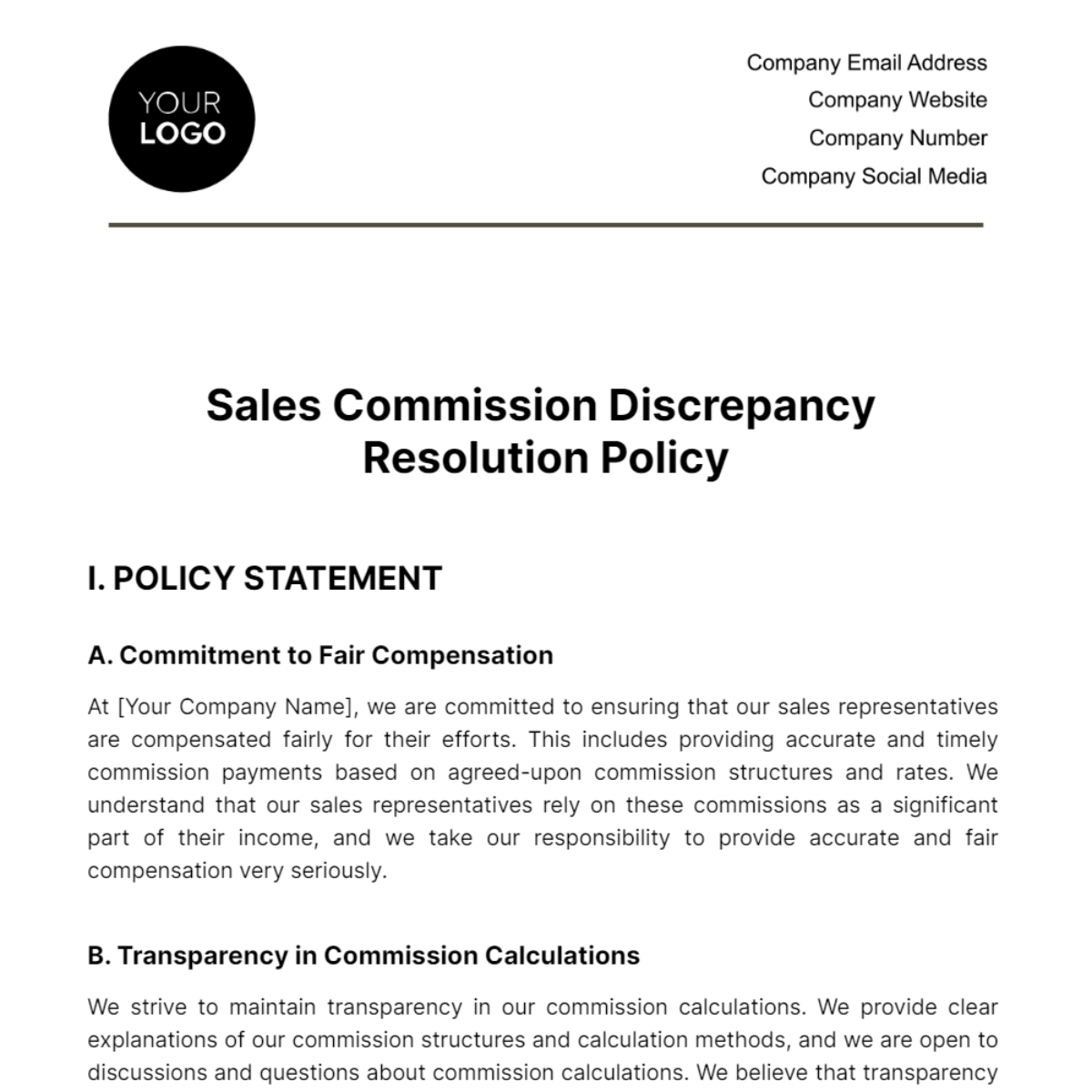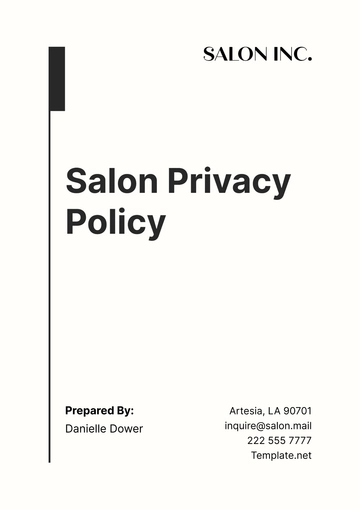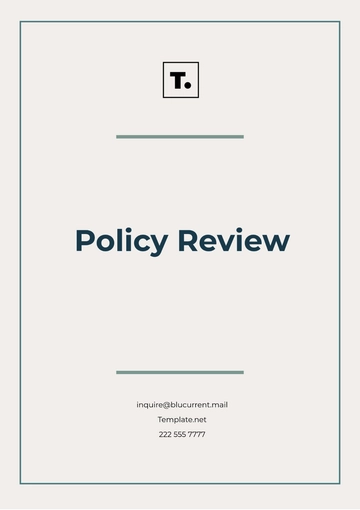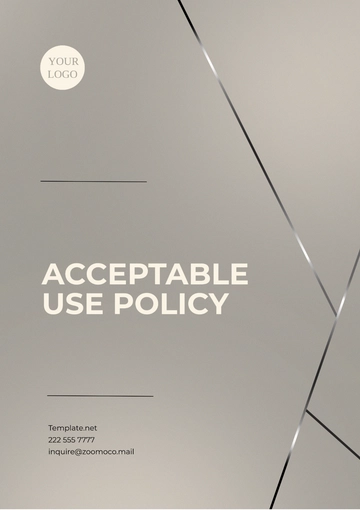Free Sales Commission Discrepancy Resolution Policy

I. POLICY STATEMENT
A. Commitment to Fair Compensation
At [Your Company Name], we are committed to ensuring that our sales representatives are compensated fairly for their efforts. This includes providing accurate and timely commission payments based on agreed-upon commission structures and rates. We understand that our sales representatives rely on these commissions as a significant part of their income, and we take our responsibility to provide accurate and fair compensation very seriously.
B. Transparency in Commission Calculations
We strive to maintain transparency in our commission calculations. We provide clear explanations of our commission structures and calculation methods, and we are open to discussions and questions about commission calculations. We believe that transparency is key to building trust with our sales representatives and ensuring that they feel valued and respected.
C. Timely Resolution of Discrepancies
We understand that discrepancies can occur, and we are committed to resolving these discrepancies in a timely manner. We have established procedures to ensure that discrepancies are addressed promptly and effectively. We believe that a timely resolution of discrepancies is crucial to maintaining the trust and confidence of our sales representatives.
II. SCOPE
A. Applicability
This policy applies to all sales representatives, regardless of their employment status (full-time, part-time, or contract). All sales representatives are entitled to fair and accurate commission payments. We understand that each sales representative plays a crucial role in our company’s success, and we are committed to ensuring that all sales representatives are treated fairly and equitably.
B. Coverage
This policy covers all aspects of commission, including the calculation of commission, the payment of commission, and the resolution of any discrepancies that may arise in relation to commission. We understand that commission calculations can be complex and that discrepancies can occur. This policy provides a clear and comprehensive framework for addressing and resolving any such discrepancies.
III. PROCEDURE FOR RESOLUTION
A. Identification of Discrepancy
A commission discrepancy may be identified by the sales representative, their manager, or the Sales Operations Manager. The identification process includes:
Regular Review: Sales representatives and managers should regularly review commission calculations as part of their routine duties. This involves checking the accuracy of the calculations, ensuring that all relevant sales transactions have been included, and that the correct commission rates have been applied.
Self-Audit: Sales representatives are encouraged to conduct self-audits of their commission calculations. This involves independently calculating their commissions based on their sales records and comparing these calculations with the commissions they have received. Self-audits can help sales representatives understand their commission structure better and identify any potential discrepancies early.
Reporting: If a discrepancy is identified, it should be promptly reported to the relevant parties. This includes the sales representative’s manager and the Sales Operations Manager. Prompt reporting ensures that the discrepancy can be addressed and resolved as quickly as possible.
Collaboration: Sales representatives and managers should collaborate with each other and with the Sales Operations Manager to identify and resolve discrepancies. Collaboration can lead to a more thorough understanding of the discrepancy and more effective solutions.
Training: Regular training sessions should be conducted to ensure that all sales representatives and managers are well-equipped to identify and report discrepancies. Training can also help to prevent discrepancies from occurring in the first place.
B. Documentation
The sales representative or their manager should document the discrepancy in detail. The documentation process includes:
Detailing the Discrepancy: The discrepancy should be described in detail. This includes specifying the sales transactions and order numbers involved, explaining how the commission was calculated, and indicating where the discrepancy lies.
Gathering Supporting Documents: All documents that support the discrepancy claim should be gathered. This includes sales contracts, invoices, customer records, and any other documents that provide evidence of the sales transactions and the commission calculations.
Retention of Documents: All documents related to the discrepancy should be retained until the discrepancy is fully resolved. These documents may be needed for reference during the resolution process and for any potential audits.
C. Submission of Discrepancy
The sales representative should submit the documented commission discrepancy. The submission process includes:
Preparation of Submission: The sales representative should prepare a comprehensive submission package that includes the documented discrepancy and all supporting documentation. The submission should be clearly organized and easy to understand.
Timely Submission: The discrepancy should be reported within [30] days of the commission calculation in question. Timely reporting allows the discrepancy to be addressed and resolved as quickly as possible.
Receipt of Submission: The sales representative should ensure that their supervisor or manager has received the submission and is aware of the discrepancy. This may involve following up with the supervisor or manager after the submission has been made.
D. Manager’s Review
The manager’s review includes:
Review of Submission: The manager should thoroughly review the submitted discrepancy and all supporting documentation. This involves checking the accuracy of the information provided, understanding the nature of the discrepancy, and identifying any potential causes.
Investigation: The manager should initiate an investigation to determine the cause of the discrepancy. This may involve reviewing sales records, commission calculations, and other relevant information.
Consultation: The manager may need to consult with the Sales Operations Manager and other relevant parties to gather additional information. This can help to ensure a thorough and accurate understanding of the discrepancy.
E. Resolution Meeting
If the manager is unable to resolve the discrepancy promptly, the resolution meeting includes:
Scheduling the Meeting: The manager should schedule a meeting at a time that is convenient for all participants. The meeting should be scheduled as soon as possible to ensure a timely resolution of the discrepancy.
Discussion: During the meeting, the participants should discuss the discrepancy and share their findings. This is an opportunity for all parties to gain a better understanding of the discrepancy and to contribute to the resolution process.
Collaborative Resolution: The participants should work collaboratively to develop a resolution to the discrepancy. This may involve brainstorming solutions, making decisions about how to adjust the commission calculations, and planning for the implementation of the resolution.
F. Resolution Plan
Following the resolution meeting, a plan of action will be developed to address the discrepancy. This includes:
Development of Plan: The manager, in consultation with the Sales Operations Manager and the sales representative, should develop a comprehensive plan of action to address the discrepancy. The plan should clearly outline the steps that will be taken to resolve the discrepancy and prevent similar discrepancies in the future.
Communication of Plan: The plan should be communicated to the sales representative and any other relevant parties. Clear communication ensures that everyone understands the plan and their roles in implementing it.
Implementation of Plan: The plan should be implemented as soon as possible. This may involve making adjustments to the sales representative’s commission payments, changing the commission calculation process, or taking other actions as outlined in the plan.
G. Resolution Timeline
[Your Company Name] is committed to resolving commission discrepancies promptly. The resolution timeline includes:
Initial Resolution Period: The initial resolution period is [30] days from the date of the resolution meeting. During this time, all efforts will be made to resolve the discrepancy.
Extension for Complex Cases: If the discrepancy is complex and cannot be resolved within the initial resolution period, an extension may be granted. The length of the extension will depend on the complexity of the discrepancy and the progress of the resolution process.
Regular Updates: Throughout the resolution process, the sales representative should be provided with regular updates. These updates should include information on the progress of the resolution process, any changes to the resolution plan, and an updated timeline for resolution.
H. Final Decision
If a satisfactory resolution cannot be reached through the above steps, the final decision includes:
Review of Information: The Sales Operations Manager and senior management should conduct a thorough review of all available information. This includes the documented discrepancy, supporting documentation, findings from the manager’s review, discussions from the resolution meeting, and any other relevant information.
Consultation with Senior Management: The Sales Operations Manager should consult with senior management to ensure that the final decision is fair and equitable. Senior management can provide valuable insights and perspectives that can help to inform the final decision.
Communication of Decision: Once the final decision has been made, it should be communicated to the sales representative and any other relevant parties. The communication should include an explanation of the decision and any implications for the sales representative’s commission payments.
I. Communication of Resolution
The communication of resolution includes:
Notification of Outcome: The sales representative should be notified of the outcome of the resolution process as soon as possible. The notification should include a clear explanation of the resolution and any changes to the sales representative’s commission payments.
Adjustment of Payments: Any necessary adjustments to the sales representative’s commission payments should be made promptly. This ensures that the sales representative receives the correct commission payments as soon as possible.
Confirmation of Adjustment: Once the adjustments have been made, the sales representative should be provided with a confirmation. The confirmation should include details of the adjustments and an updated statement of the sales representative’s commission payments.
IV. NON-RETALIATION POLICY
A. Protection from Retaliation
We assure all employees that they will not face any form of retaliation for reporting a commission discrepancy or participating in the resolution process. This includes protection from adverse employment actions such as termination, demotion, or harassment. We believe that employees should feel safe and supported when raising concerns or reporting discrepancies.
B. Open and Supportive Environment
We strive to foster an open and supportive environment where employees feel safe to report discrepancies and contribute to the resolution process. We encourage open communication and constructive feedback, and we value the contributions of all employees in ensuring the accuracy and fairness of commission payments.
V. REVIEW AND AMENDMENT
A. Periodic Review
We will conduct periodic reviews of this policy to ensure that it remains effective in addressing commission discrepancies. These reviews will consider changes in our business operations, feedback from employees, and any legal or regulatory developments. We are committed to continuous improvement and we welcome feedback from all employees on how we can improve this policy.
B. Amendments
Any necessary amendments to this policy will be made in consultation with relevant stakeholders. This includes sales representatives, who are directly affected by the policy, as well as managers and the Sales Operations Manager, who are responsible for implementing the policy. We will communicate any changes to the policy to all affected employees in a timely manner. We believe that involving all relevant stakeholders in the amendment process ensures that the policy remains effective and relevant.
- 100% Customizable, free editor
- Access 1 Million+ Templates, photo’s & graphics
- Download or share as a template
- Click and replace photos, graphics, text, backgrounds
- Resize, crop, AI write & more
- Access advanced editor
Maintain trust and transparency in your sales team with our editable Sales Commission Discrepancy Resolution Policy Template! This fully customizable tool from Template.net, allows you to create a fair and clear policy for resolving commission discrepancies. The AI Editor Tool simplifies this process, helping you build a harmonious sales team!
You may also like
- HR Policy
- Restaurant Policy
- Company Policy
- Accounting Policies and Procedures
- Website Policy
- Privacy Policy
- Safety Policy
- School Policy
- IT and Software Policy
- Law Firm Policy
- Construction Policy
- Interior Design Policy
- Travel Agency Policy
- Education Academic Policy
- Security Policy
- Real Estate Policy
- Expense Policy
- Software Policy





























